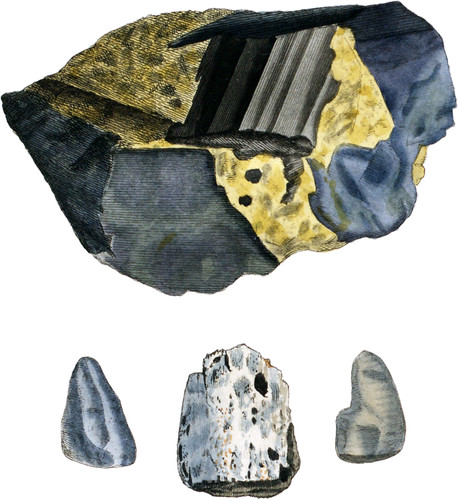 Enlarge
Enlarge
Exotic Mineralogy
Dichoite
- Syn.
- Iolith. Werner and Karsten.
- Iolithe. Haüy Tabl. 61.
- Dichroïte. Cordier, Journal des Mines, xxv. 129. Bournon Catal. 51.
- Iolite. Aikin, 194.
- Steinheilite. Berzelius, &c.
The lending variety of this mineral was found near 30 years ago, in the neighbourhood of the Cape de Gate, in Spain, in grains dispersed through gneiss, in a decomposing slate that contained many garnets: after a while the French Mineralogists suspected, that what has often been called blue Quartz by authors, and Water Saphire by jewellers, was a variety of Iolite; Cordier, discovering that different colours were transmitted through it in different directions, rendered this opinion more plausible, and named the substance Dichroite:—hitherto it had occured in grains or ill defined prisms of either 6 or 12 sides, but it has since been discovered in large prismatic masses, among Copper Pyrites, at Orrayervi, in Finland, and named Steinheilite, after Count Steinheil, Governor-General of that district, who has contributed much towards the progress of Mineralagy in the north: the analyses given below, prove all three to be varieties of one species, if the substance be a distinct species itself.
Cordier has described a cleavage parallel to a 12-sided prism, but this is very indistinct, and may arise only from an aggregation of plates around a prism of that form, without indicating the integrant molecule: upon a careful examination of the Saphire d'eau, and the Steinheilite, a fibrous structure may be discerned, or at least they appear to be penetrated by fibres, and it is in the longitudinal direction of these fibres that the blue colour is conspicuous; but while looking through their side, in which direction they of course are most visible, the mineral appears of a light dull yellowish brown; the direction of the fibres also corresponds with the axis of the prism. Is it not possible that this substance may be Quartz, penetrated by transparent blue Tourmaline, in fin capillary crystals? it is well known that Tourmaline possesses the same character of transmitting different coloured light, or different quantities of light in different directions. A capillary variety of the exact colour is found in Cornwall, and exhibited on tab. 483, in my British Mineralogy.
The variety fromt he Cape de Gate is rare. I have been enabled to give but a small figure of it, from a specimen in the Collection formerly possessed by the Count de Bournon, and with the use of which I was so freely indulged by him. I have given two views of the variety called Water Saphiro, from a specimen lent, me by my kind friend Mrs. C. Codrington; it had been polished and perforated before it was broken: it shews the fibres in the interior very distinctly. The exact locality of this variety does not seem to be known: it is by some said to come from India, and by others from Macedonia. The largest figure is from a Swedish specimen in the British Museum; it shews the sections of two prisms, and the side of a third: they all appear to be rectangular, with their longitudinal edges replaced by three planes of various extent: should this prove, from the examination of more perfect crystals, to be the real form, it will militate strongly against the idea of their being Quartz, either with or without Tourmaline. That it is not pure Quartz has been proved by Gadolin, who found it to contain a large quantity of Alumina. The prisms are coated with a black substance firmly united to them.
Dr. Leopold Gmelin has favoured us with the following analyses:
| The Iolite, from the Cape de Gate, contains | The Saphire d’Eau. | |
|---|---|---|
| Silica | 42.6 | 43.6 |
| Alumina | 34.4 | 37.6 |
| Magnesia | 5.8 | 9.7 |
| Lime | 1.7 | 3.1 |
| Potash? | 1.0 | |
| Oxide of Iron | 15.0 | 4.5 |
| Oxide of Manganese | 1.7 | a trace. |
| 101.2 | 99.5 | |
Dichroite has a specific gravity of about 2.56, and is difficultly fusible by the blow-pipe into a greyish green enamel.

